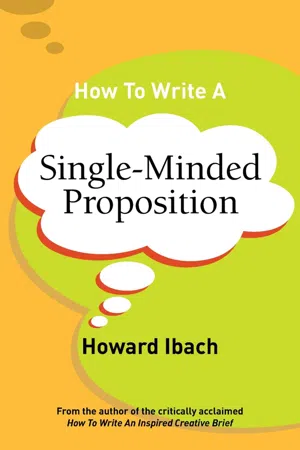
How To Write A Single-Minded Proposition
Five insights on advertising's most difficult sentence. Plus two new approaches.
- English
- ePUB (mobile friendly)
- Available on iOS & Android
How To Write A Single-Minded Proposition
Five insights on advertising's most difficult sentence. Plus two new approaches.
About this book
What is a single-minded proposition? If you know Nike, you know the answer: Just Do It. This is the iconic line known and loved by Nike users worldwide that began its life as a single-minded proposition on a creative brief. Most SMPs don't become this famous. That's because they are exceedingly hard to write. But when they're done well, sometimes they reach this exalted status.
From the author of the critically acclaimed How To Write An Inspired Creative Brief 2nd edition comes a new critically acclaimed graphic text devoted exclusively to this small collection of wordsonthe creative brief: How To Write A Single-Minded Proposition: Five insights on advertising's most difficult sentence. Plus two new approaches.
In a step-by-step process, Howard demonstrates how fivekey ingredientson every creative brief work together to produce the single-minded proposition (SMP), the singular messagethatexplains your brand's promise. He interviewed over 30 advertising and marketing professionals all over the globe for their thoughts on this one key line. Then he introduces you to two thought leaders who offer alternative ideas on where the creative brief can go.
This neat package of thought-provoking ideas, easy-to-do practical exercises, andfun graphics fit together in a concise and compelling 100 pages. A quick read that you'll return to regularly for its clear explanations and valuable examples.
Frequently asked questions
- Essential is ideal for learners and professionals who enjoy exploring a wide range of subjects. Access the Essential Library with 800,000+ trusted titles and best-sellers across business, personal growth, and the humanities. Includes unlimited reading time and Standard Read Aloud voice.
- Complete: Perfect for advanced learners and researchers needing full, unrestricted access. Unlock 1.4M+ books across hundreds of subjects, including academic and specialized titles. The Complete Plan also includes advanced features like Premium Read Aloud and Research Assistant.
Please note we cannot support devices running on iOS 13 and Android 7 or earlier. Learn more about using the app.
Information
TBWA\Chiat\Day
New York
CEO Brain Traffic;
author, Content Strategy for the Web, 2nd edition

The pressure to get it right is significant.

New York University, and Chief Experience Officer
RL Gant Group Inc., New York
Bold Orange, Minneapolis


Table of contents
- Cover Page
- Title Page
- Copyright Page
- Dedication
- Table of Contents
- Introduction
- 1. Why I wrote this book
- 2. A hard question, a simple answer
- Section I: Where we are
- Section II: Where we can go
- Final thoughts
- Acknowledgments
- Bibliography
- About the author